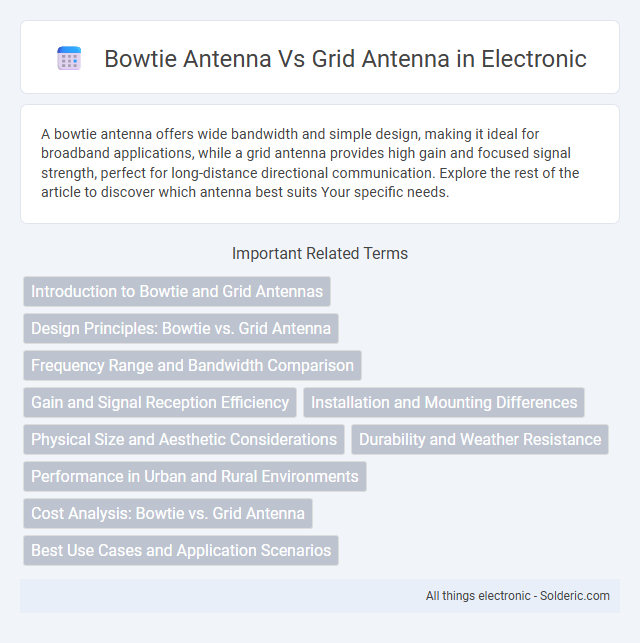A bowtie antenna offers wide bandwidth and simple design, making it ideal for broadband applications, while a grid antenna provides high gain and focused signal strength, perfect for long-distance directional communication. Explore the rest of the article to discover which antenna best suits Your specific needs.
Comparison Table
| Feature | Bowtie Antenna | Grid Antenna |
|---|---|---|
| Design | Two triangular conductive elements forming a bowtie shape | Metal wire mesh or rods arranged in a grid pattern |
| Frequency Range | Wideband, typically UHF to microwave frequencies | Narrow to moderate bandwidth, optimized for specific frequency bands |
| Gain | Moderate gain (5-8 dBi) | High gain (10-20 dBi), directional |
| Polarization | Linear polarization | Mostly linear polarization, can support dual polarization with design |
| Radiation Pattern | Wide beamwidth, broad coverage | Narrow beamwidth, focused directional signal |
| Applications | TV reception, UHF & microwave communications | Point-to-point communications, wireless networking, radar |
| Construction | Simple, flat structure, easy to fabricate | More complex, requires framework for grid support |
| Wind Load | Higher wind resistance due to flat surface | Lower wind resistance due to open grid design |
Introduction to Bowtie and Grid Antennas
Bowtie antennas consist of two triangular metal plates shaped like a bowtie, designed to provide wide bandwidth and high gain, making them ideal for UHF and VHF signals. Grid antennas feature a parabolic reflector made of parallel metal rods, offering focused directional gain and resistance to wind, best suited for long-range point-to-point communication. Both antenna types serve specific applications based on frequency range, gain requirements, and environmental factors.
Design Principles: Bowtie vs. Grid Antenna
Bowtie antennas utilize a planar, triangular element design that provides a wide bandwidth and omnidirectional radiation pattern, ideal for broad frequency reception in compact form. Grid antennas employ a series of parallel conductive rods arranged in a grid pattern, creating directional gain and enhanced signal strength by focusing energy toward the target signal source. Your choice depends on whether you prioritize wide frequency coverage with uniform reception (bowtie) or concentrated signal reception with higher gain (grid).
Frequency Range and Bandwidth Comparison
Bowtie antennas typically cover a wider frequency range, often spanning from VHF to UHF bands (30 MHz to 3 GHz), providing broad bandwidth ideal for multi-frequency applications. Grid antennas, designed primarily for focused high-gain performance, usually operate within narrower frequency bands, often optimized for specific UHF or microwave frequencies around 900 MHz to 5 GHz. The wider bandwidth of bowtie antennas enables versatile use across diverse frequency ranges, while grid antennas prioritize gain and directivity within targeted frequency bands.
Gain and Signal Reception Efficiency
Bowtie antennas typically offer moderate gain and wide bandwidth, making them suitable for reliable signal reception across various frequencies. Grid antennas boast higher gain and superior signal reception efficiency due to their focused, directional design, ideal for long-distance communication. Choosing your antenna depends on whether you prioritize broad coverage (bowtie) or enhanced signal strength and range (grid).
Installation and Mounting Differences
Bowtie antennas typically feature a compact, planar design that facilitates straightforward wall or mast mounting using standard brackets, making installation relatively quick and simple. Grid antennas, with their larger, curved reflector and open-grid structure, require more precise alignment and sturdy mounting hardware to maintain optimal signal direction and stability in outdoor environments. The complexity of grid antenna installation often involves additional support to withstand wind loads, whereas bowtie antennas are generally lighter and easier to secure in tight spaces.
Physical Size and Aesthetic Considerations
Bowtie antennas feature a compact, flat design that is generally smaller and less visually intrusive, making them suitable for installations where space is limited or discreet appearance is desired. Grid antennas are larger with a distinctive mesh structure, which can be bulkier and more conspicuous but offer durability and effective wind resistance. The choice between the two depends on balancing the need for minimal physical footprint against the robustness and visibility acceptable in the installation environment.
Durability and Weather Resistance
Bowtie antennas feature solid metal construction with fewer exposed parts, providing enhanced durability and resistance to harsh weather conditions such as heavy rain and wind. Grid antennas, while offering superior signal gain, have open wire mesh designs that make them more susceptible to corrosion and physical damage from debris or ice accumulation. Choosing between the two depends on environmental factors; bowtie antennas are typically preferred for long-term outdoor use in severe climates due to their robust weather resistance.
Performance in Urban and Rural Environments
Bowtie antennas offer superior performance in urban environments due to their broad bandwidth and ability to reduce multipath interference, ensuring clearer signal reception amidst buildings and obstacles. Grid antennas excel in rural areas by providing higher gain and focused reception over long distances, making them ideal for capturing weak signals from distant broadcast towers. Both antenna types are optimized for different settings: bowtie antennas for urban signal clarity and grid antennas for rural range and directionality.
Cost Analysis: Bowtie vs. Grid Antenna
Bowtie antennas generally offer lower manufacturing costs due to simpler materials and design, making them a cost-effective option for budget-conscious installations. Grid antennas, while more expensive initially because of their complex structure and durable components, provide higher gain and better resistance to wind and weather conditions, reducing long-term maintenance expenses. Evaluating total cost of ownership, bowtie antennas suit short-term or indoor uses, whereas grid antennas deliver greater value in outdoor, high-performance applications despite higher upfront investment.
Best Use Cases and Application Scenarios
Bowtie antennas excel in wideband applications such as television reception and broadband communications, where signal bandwidth and uniform frequency response are critical. Grid antennas offer superior directional gain and wind resistance, making them ideal for long-distance point-to-point wireless links and areas with strong wind conditions. Choosing between these antenna types depends on your need for wide frequency coverage or focused signal strength and environmental durability.
bowtie antenna vs grid antenna Infographic

 solderic.com
solderic.com